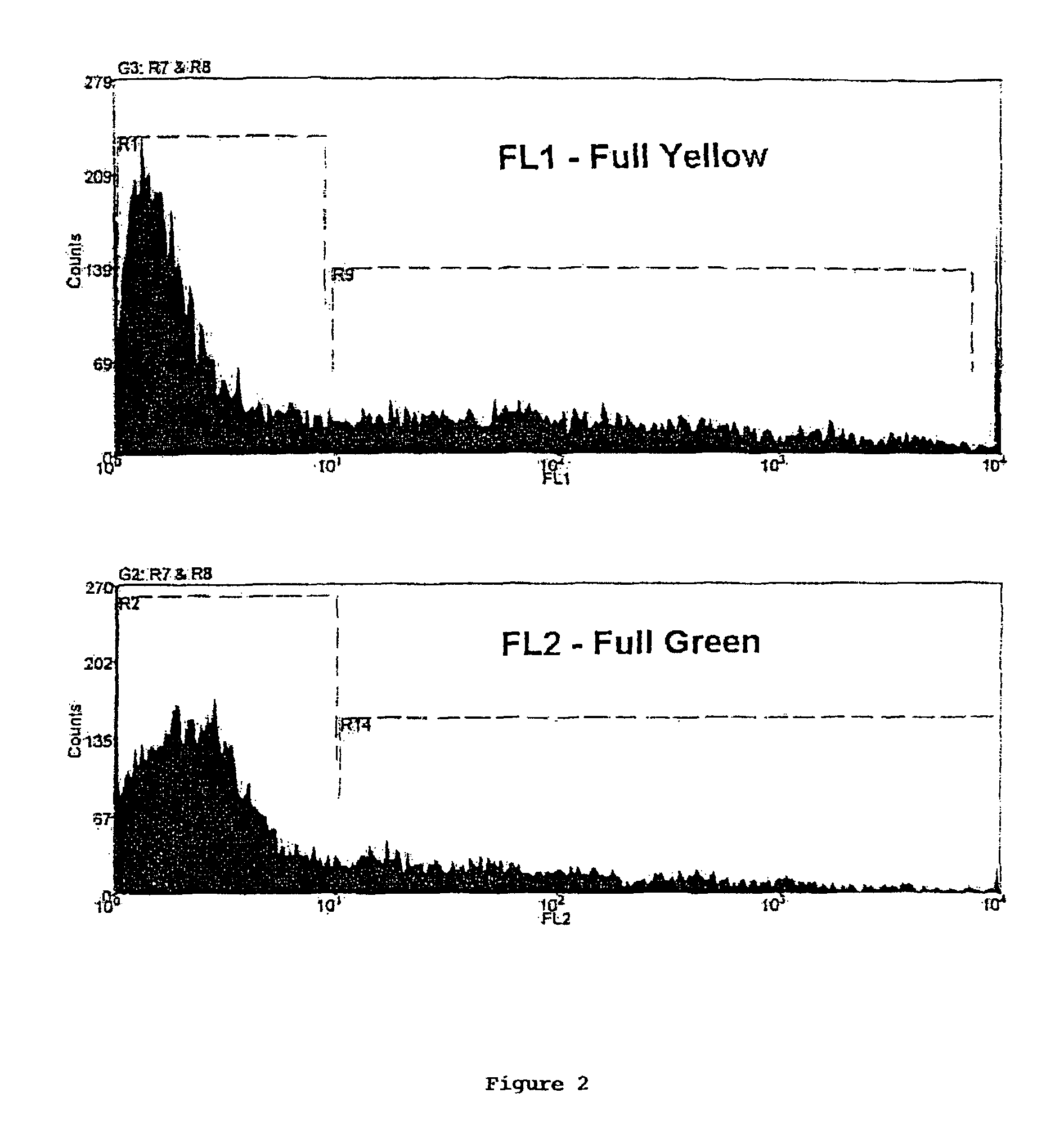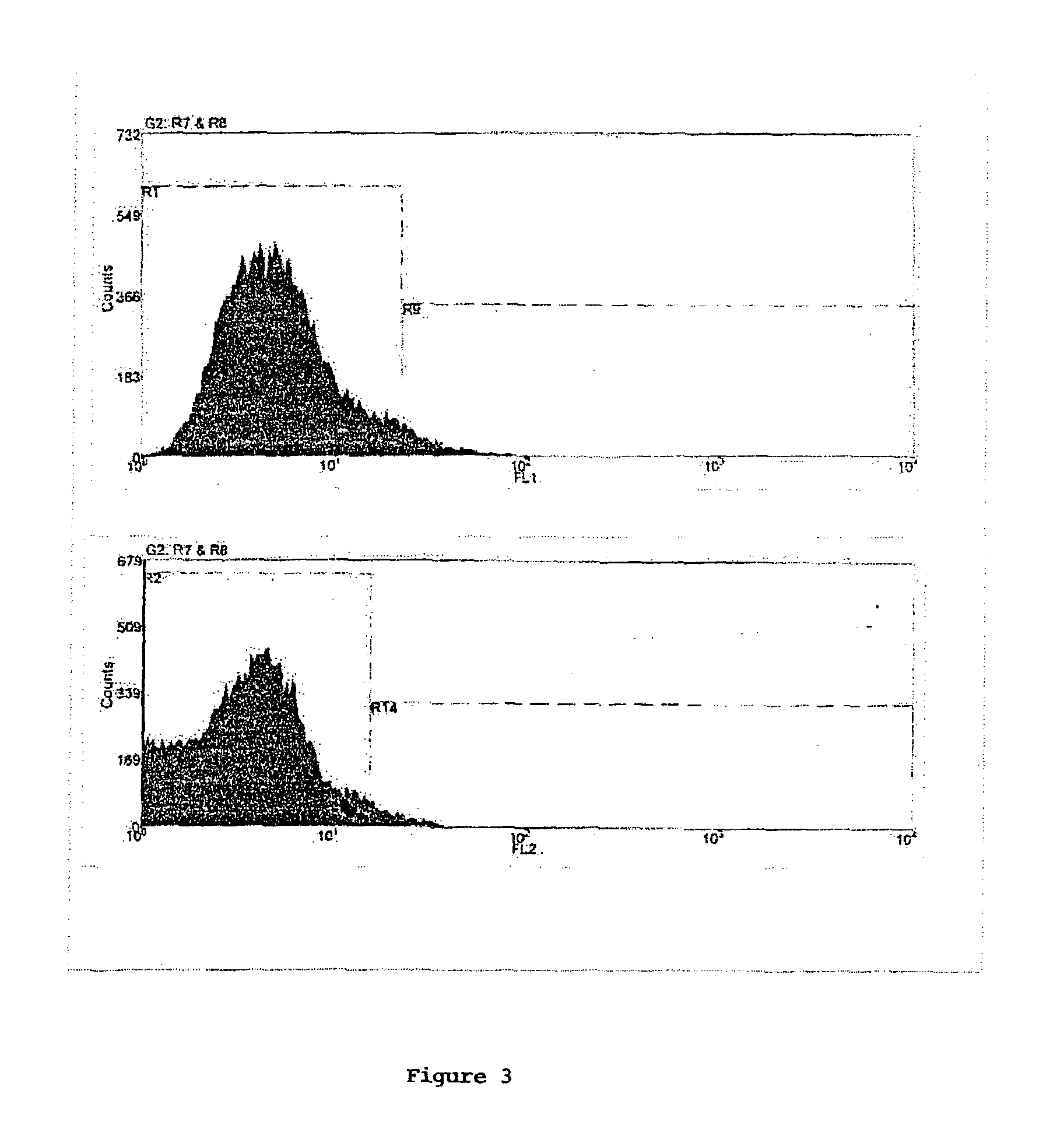Method of screening multiply transformed cells using bicistronic expression of fluorescent proteins
a technology of fluorescent proteins and transfected cells, applied in the field of screening transformed or transfected cells, can solve the problems of slow identification of cells expressing the exogenous gene encoded by the transfected dna, inability to meet the needs of biopharmaceutical production, and inability to meet the requirements of biopharmaceutical production,
- Summary
- Abstract
- Description
- Claims
- Application Information
AI Technical Summary
Benefits of technology
Problems solved by technology
Method used
Image
Examples
example 1
Preparation of DNA
[0084]Transfection quality DNA was produced using standard preparation techniques. Double cesium chloride, PEG precipitation or anion exchange columns may be used for preparation of such DNA. The method described here details the preparation of 25 ml E. Coli DH5α cultures for extraction of approximately 100 μg of transfection quality plasmid DNA using QIAFilter Midiprep anion exchange columns (Qiagen, Germany). Thus, fresh kanamycin (50 μg / ml) LB agar plates were streaked with glycerol stocks of E. Coli DH5α containing two pNK derived expression vectors (pNK-c30.6γ-IRES-EGFP and pNK-c30.6κ-IRES-EYFP). The pNK vectors used as the “backbone” in these examples of the dual expression system have recently been described (Bailey et al. 1999).
[0085]The pNK vector includes a multiple cloning site into which an antibody gene-IRES-fluorescent protein expression cassette was cloned (between ClaI and BclI restriction sites). Two vectors each including a different expression ca...
example 2
Transfection of DNA
[0106]Transfection of plasmid DNA into cells may be performed by many methods, including CaPO4 precipitation, lipofection, electroporation and others. The following describes the use of Lipofectamine 2000 (a commercially available lipid derived system—GibcoBRL) which has provided good frequencies of transfection in attached and suspension CHO cells. The use of DMRIE C reagent (GibcoBRL) for high transfection efficiency where transfection of suspension cells is performed is also described.
[0107]For transfection using Lipofectamine 2000 (LF2000): The day before transfection 2×105 CHO-K1 cells were plated in wells of a 6 well plate with 2.5 ml of culture media with 10% fetal calf serum (e.g. DMEM:Coons F12 [a 1:1 mix]). As a result cells were 90-95% confluent on the day of transfection. 4 to 5 μg of DNA was diluted into 250 μl of serum free medium (e.g. Opti-MEM 1 media-Gibco BRL). 12 to 15 μl LF2000 was also diluted into another 250 μl of serum free medium and incub...
example 3
Selection of Cells Transfected with DNA
[0110]In the case of attached CHO cells, 24 hours post transfection cells were detached in 500 μl 1:1 trypsin:versene solution, pelleted and resuspended in 500 μl growth media and inoculated into a large volume tissue culture flask (T75 or T150) in the presence of suitable media.
[0111]Suspension cells may also be used and may be cultured in T25 or T75 flasks which are untreated for tissue culture. When suspension cells were used, the flasks were shaken on an orbital platform at approximately 125 rpm. Suspension cells were also pelleted, resuspended and transferred to culture in 100 ml spinner bottles in the presence of suitable media.
[0112]After a further 24 hours, attached cells were selected with 500 μg / ml G418 (Geneticin) and / or 100 μM Zn2+SO42− and 2 μM Cd2+Cl2− while the suspension cells are more sensitive due to the absence of serum and are therefore selected in 250 μg / ml G418. Selection was continued for 14 days with media and supplement...
PUM
| Property | Measurement | Unit |
|---|---|---|
| volume | aaaaa | aaaaa |
| volume | aaaaa | aaaaa |
| wavelength | aaaaa | aaaaa |
Abstract
Description
Claims
Application Information
 Login to View More
Login to View More - R&D
- Intellectual Property
- Life Sciences
- Materials
- Tech Scout
- Unparalleled Data Quality
- Higher Quality Content
- 60% Fewer Hallucinations
Browse by: Latest US Patents, China's latest patents, Technical Efficacy Thesaurus, Application Domain, Technology Topic, Popular Technical Reports.
© 2025 PatSnap. All rights reserved.Legal|Privacy policy|Modern Slavery Act Transparency Statement|Sitemap|About US| Contact US: help@patsnap.com



